Whether you are thinking of creating a radio station for your news outlet to attract new audiences or revenue streams, or planning a radio station as a side project, this guide will explain how to launch an online radio station in less than one hour on a zero or very low budget.
The Boston Globe launched an internet-only radio station last year, which Ken Dardis, president of the consulting firm Audio Graphics Inc, described in the Globe's report on the launch as "a good fit for newspaper companies because they already have the content”. Your news outlet may have an archive of podcasts and audio interviews which could be webstreamed and showcased.
This guide helps you set up internet radio without requiring any technical ability. Your radio station runs from your web browser – and there is also the option of streaming live reports from your smartphone.
The radio station is created using Airtime, which launched exactly two years ago. There is a free, open source option, which is free to download and runs on Ubuntu and Debian, and requires more technical ability to set up. We do not go in to this in this guide. There is also Airtime Pro, a cloud-hosted, paid-for version of the free software, which this how to covers. The interface for Airtime and Airtime Pro is identical. For those wishing to use the platform for free, an option would be to sign up for a free trial with Airtime Pro and then opt to self-host once you have tried it out.
Airtime can not only be used as the studio for an online radio station, it can also broadcast on air, on digital and on satellite, and is used by radio stations including Resonance FM in London and West Africa Democracy Radio (WADR). It is made by Sourcefabric, a non-profit organisiation that promotes independent journalism and works in many countries where media freedom is a challenge.
Airtime 2.3 is the latest release and goes live today (13 February 2013), timed to coincide with the second World Radio Day.
The guide
1. Sign up for Airtime Pro. There is a free one-month trial and then you can explore the free open source Airtime route or start paying. Costs start at $25 per month for Airtime Pro, plus a streaming charge of $17 per month. Sign up for the free trial here. You will need to wait for a few hours for your account to be activated.
If you sign up via Airtime Pro for streaming, the support team will enter the streaming details (Icecast or SHOUTcast) on your behalf. You can see the settings in 'system' / 'streams' within Airtime.
2. Upload audio. Once you have signed up, your radio studio is in your web browser. You now need to upload audio – which is a bit like adding tracks and creating playlists within iTunes.
Go to the second tab along and click on 'add audio', drag the files you have on your computer to the upload area and then click 'start upload'. The upload process is very quick.

You will need to be aware of whether you own the copyright to your audio interviews and podcasts. In addition to your own audio, you can download and broadcast audio that is licensed under creative commons.
Use this creative commons link to search audio platform SoundCloud for appropriate podcasts and interviews for your radio station.
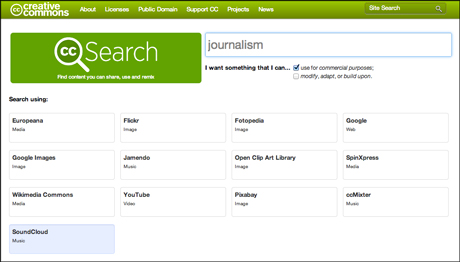
Be aware that radio stations are required to pay rights and royalties to play music.
3. Schedule shows. Airtime has a calendar, similar to a Google Calendar, that lets you plan shows and drag and drop the audio to be automatically played out at that show time.
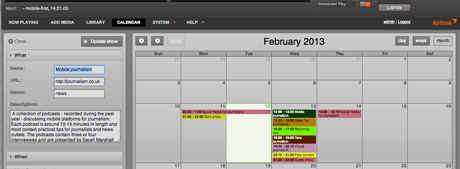
Before you start scheduling, check that your date and time zone is correct (under 'system' / 'preferences').
In the 'calendar' tab, click '+ show' and fill in the name and show details.
Now you need to add audio tracks to your show. Click on the show name within the calendar and click on 'add / remove content'.
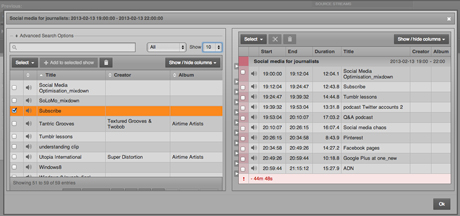
You can now drag the content that you want in your show from the library displayed on the left to the show area on the right. You can move and re-order tracks by dragging and dropping. Airtime will tally up the time the audio will take to play out and tell you whether the total audio is too long or short for the show time.
4. Going live. Your radio station will begin broadcasting as soon as the date and time arrives for your scheduled show. The On Air button will turn to red and the details of the current track and next track will be displayed along the top of Airtime. If it does not go live as expected, check the time and date zone (within 'system' / 'preferences').
5. Listen and share. You can listen to your internet radio station and share the URL so others can too. Click the 'listen' button and then click the orange 'share' button within the pop up box.

You can also share the URL by copying and pasting the 'stream URL' listed in 'streams' within 'preferences'. It does not matter which of the two / three stream URLs you share, (there is more than one stream so they can broadcast at different bitrates).
There is also a widget you can embed within your site. It is within 'system' / 'preferences'. Note that some CMSs do not permit Javascript. To add to WordPress you will need a Javascript plugin, such as Inline Javascript Plugin.
You are now live but there are two more things worth noting as you start using Airtime Pro.
6. Smart Blocks. When Adam Thomas from Sourcefabric, which makes Airtime, was talking us through the features, he explained that using 'smart blocks' is a bit like setting up 'recipes' in If This Then That (IFTTT), the free online tool that connects your social accounts. (We have a journalist's guide to IFTTT here.)
Smart blocks involves setting parameters by which audio is randomly generated. Thomas used the example of "play me an hour of all audio tagged 'politics' that has been uploaded in last 30 days". You can set smart blocks by going to 'library' / 'new' / 'new smart block'.
7. Go live from your phone. Airtime can also broadcast / re-broadcast a stream coming in from a URL. Adam Thomas said this could be from another radio station (with permission). Or you could use an iPhone or an Android app that creates webstreams. There is a handy post on how to turn your iPhone into a radio station here.
The suggestion in the post is to buy an iPhone app called Papaya Broadcaster, which costs £3.99. Android users can download BroadcastYourSelf, which is free of charge.
The following screenshot provides the settings you need to enter within the app. In the 'settings' name = 'Airtime', server = yourservername.in.airtime.pro, port = 8001, mountpoint = yourservername_master, stream name = any word to describe so you can identify the stream, description = mp3 Bitrate: 128, genre = any word, username = set a username, password = set a password, codec = mp3, bitrate = 128, protocol = Icecast2, stereo = on.
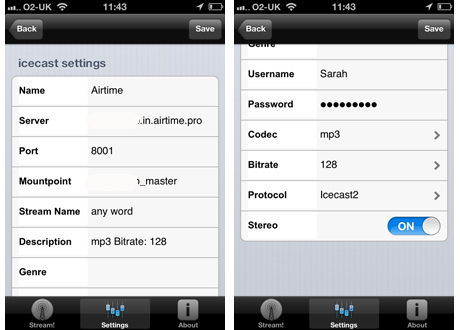
Now add the settings in Airtime. You will see the input stream settings within 'preferences' / 'streams'. Enter your username and password (as set in the app) and tick the 'auto switch on', so that when you hit play in the app to broadcast, it will take the phone input rather than playing out the automated playlist, and the 'auto switch off'.
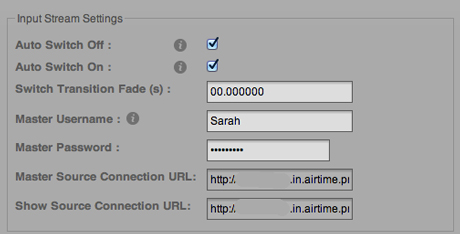
Whenever you are ready to do an outside broadcast from your phone, all you have to do is turn on the smartphone app and hit the 'play' logo in 'stream' and it will go live.
Now you have an internet radio station that will automatically broadcast your content and you can add live reports using your phone.
Useful links:
- The how to create a radio station in 6 seconds Vine (a video we made to show how easy it is)
- The latest Airtime Pro manual (note the orange area on the left)
In order to test out Airtime and write this guide, we uploaded a year's worth of Journalism.co.uk podcasts, plus searched for and found journalism and tech-related podcasts under creative commons in SoundCloud.
We found that we could group the podcasts under show themes, such as 'social media for journalists', which includes podcasts on Pinterest, Tumblr and Facebook, and 'paid-content', on the topics of paywalls and microsurveys.
For our test radio station we scheduled a series of shows which are broadcasting today (13 February). They are collections of our podcasts, with a 'guest show' of podcasts about journalism from other providers.
Once we started searching we realised there was great content available under creative commons on SoundCloud, including podcasts such as these from ProPublica and these from Global Voices.
- Listen to Journalism.co.uk's test radio station at this link. It seems to work best in Chrome.
Free daily newsletter
If you like our news and feature articles, you can sign up to receive our free daily (Mon-Fri) email newsletter (mobile friendly).
Related articles
- Drew Hyndman, researcher for BBC News, on short-form vs long-form audio
- Six ingredients for a perfect audio story
- The Times set to launch a radio station to capture new subscribers
- Pilot placement scheme to help BAME journalists break into radio and podcast
- Tip of the day: How to find paid broadcast experience










